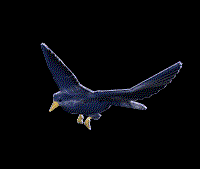Theory of flapping flight
A quote by Albert Einstein :
" We call it theory when we know much about something but nothing works, and practice when
everything works but nobody knows why."
With this mind, it seems to be inappropriate to discuss theory.
Thus we will just observe and analyse flapping flight.
Preamble :
In the field of rigid aerofoils, everything already seems to be discovered and
measured, whereas in the field of flexible aerofoils (as in
paragliding) theories are just starting to be developed.
The field of flapping flight remains even more unknown;
everything still remains to be discovered because all
that has been written is nonsense.

*
Notice that whatever their mass and Reynolds number, all birds fly
marvelously : from the hummingbird to the vulture, and from the insect to the
ancient dinosaur. Birds' masses range from a few
milligrams (a few micropounds) to 100 kilograms (220 lb) and wingspans from a
centimeter (1/2 in) to ten meters (30 ft).
*
To better understand flapping flight, we will make our observations on
a bird in stabilized flight, without taking into account takeoffs and
landings (which are more complex to analyze). One can
consider that during the flight, the bird carries out three essential
motions with its wings:
- a motion of vertical flap (up and down).
- a horizontal motion (forward and backward).
- a torsion motion (twist of the wings).
*
In flight, the bird has a regular trajectory, without any jerking motion.
Its body does not go up and down when the wings move down and
up. It implies that the wings carry the bird at every moment. Thus, the
lifting force remains constant. The bird does not use the energy necessary
to flap its wings to create a lifting force, but rather to propel itself forwards.
The speed obtained by the streamline flow around the winds creates sufficient
lifting force to maintain the flight.

*
Generally, the bird does not use its tail during a straight flight phase,
but remains retracted most of the time. During a cycle of flaps, the wings
exert, alternatively, a propulsion (while going down), and a deceleration
(while going up). According to whether they take place below the average plan or not,
these forces create an alternative couple
on the trim. The bird compensates this by a continuous search for balance,
moving its aerodynamic center with respect to its center of gravity (i.e.
by moving its wings back and forth alternatively). Both vertical and
horizontal motions are combined together to describe
eight-shaped kinematics of the wing.
*
In flight, on one hand, the horizontal speed due to the displacement is the same all
along the wingspan, but on the other hand, the vertical speed due to the
beat is null at the base and increases gradually to the end of the
wing. Both speeds combine together and make the angle of attack of
the airflows vary according to the position of the wing : horizontal
at the base and more vertical near the extremity. But a profile
only tolerates a small variation in its angle of incidence. Consequently, the
bird adapts its wing twist to keep a nearly constant angle of incidence.
This results in a twist of the wings ends, twisting negative while
going down, and positive while going up. As the lifting force has a
direction perpendicular to the plane of the wing, it will swing the wing
forwards during the descent (by the same way that a helicopter rotor
swings forwards and propels the aircraft horizontally). Thus it is the flapping,
associated with a judicious twist of the wings, that propels the bird and allows him to fly.
It is thanks to these ideas that the Truefly flies. Elementary, isn't it !
Perspective for the future : And one day, will we be able to fly?
Observation of birds, their performance and their capacity to
travel very long distances leads to our admiration and also teaches us
that they use the most efficient and economic mode of motion in the nature.
Man is able to ride a bicycle (layer and hull) as fast as 110km/h
(70 miles/h). Hand-gliding shows us that it is quite possible to fly at
a speed between 30 and 60 km/h (20 and 40 miles/h) with a simple and
light aircraft.

Of course, we have to take into account the efficency of this type
of propulsion, but we can see that it is possible to reproduce the
main motions of the flapping flight
on a light profiled aircraft : is it still so utopian to think that only
manpower can propel a man at 40 km/h
(25 miles/h), a speed at which it is possible to maintain flight?
The Truefly shows that it is possible by a simple and efficient mechanism to
propel an aircraft by flapping flight. The current techniques of
construction (carbon) gives us the possibility to produce a light and very
powerful aircrafts. Finally the exceptional performance of the Truefly
(which still has a significant potential of development and optimization)
shows that we are very close to our goal.
Now we can see that the solution exists, and it would be a shame, not to at least try to reach it !

